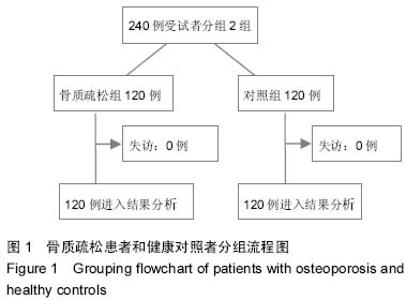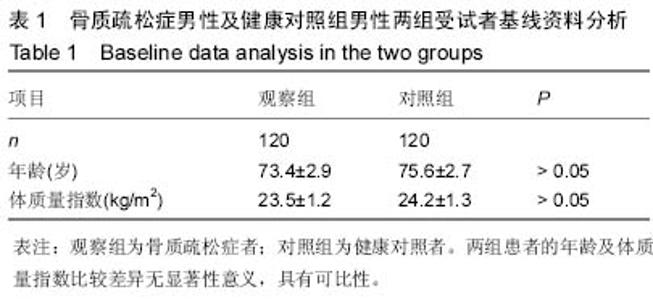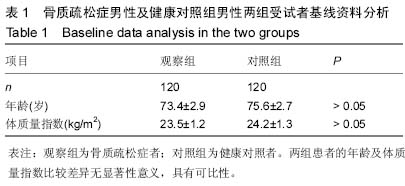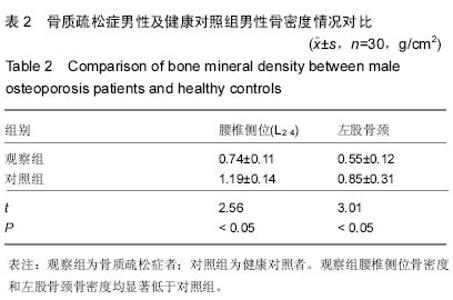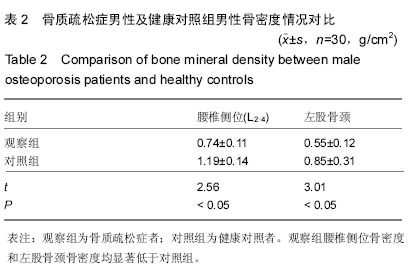| [1] Bay-Jensen AC, Slagboom E, Chen-An P, et al. Role of hormones in cartilage and joint metabolism: understanding an unhealthy metabolic phenotype in osteoarthritis . Menopause. 2013;20(5):578-586.
[2] 宋建治,肖少雄,徐礼森,等.PFNA、PFN与DHS内固定治疗老年骨质疏松性股骨粗隆间骨折疗效对比[J].中国现代手术学杂志, 2012,16(4):305-308.
[3] 刘润萍,孙丽莎,陈秋,等.胰岛素样生长因子-1与糖尿病合并骨质疏松的关系研究进展[J].中国全科医学,2013,16(3):237-239.
[4] 查小云,庞晓娜,李锂,等.中老年男性骨质疏松(OP)危险分层与定量超声骨密度(QUS-BMD)及双能X线骨密度(DXA-BMD)的相关性[J].复旦学报:医学版,2014,41(4):504-510.
[5] Steffens JP,Coimbra LS,Ramalho-Lucas PD. The Effect of Supra-and Subphysiological Testosterone Levels on Ligature-Induced Bone Loss in Rats-A Radiographic and Histological Pilot Study. J Periodontol. 2012;83(11):1432-9
[6] 栾霞,徐彤,王学宏,等.74例老年骨质疏松患者应用鲑鱼降钙素联合阿仑膦酸钠治疗的疗效观察[J].中国骨质疏松杂志, 2012, 18(10):928-931.
[7] 程晓光,刘忠厚.国际临床骨密度学会共识文件(2005年版)[J].中国骨质疏松杂志,2006,12(2):205-209.
[8] Patra D, Sandell LJ. Recent advances in biomarkers in osteoarthritis. Curr Opin Rheumatol. 2011;23(5):465-470.
[9] 楼慧玲,彭程.老年骨质疏松症患者骨折的影响因素分析[J].实用医学杂志,2012,28(20):3377-3379.
[10] 曹颖,勾登萍,朱勤岚,等.基于老年健康综合评估探讨老年骨质疏松相关危险因素[J].中国老年学杂志,2014,8(17):4947-4950.
[11] 陈祥和,李世昌,孙朋,等.小鼠生长期下坡跑改善去卵巢后骨中Ⅰ型胶原蛋白表达和骨形成[J].天津体育学院学报, 2013,28(5): 427-430.
[12] 段卫华.自发老年性骨质疏松模型SAMP6小鼠研究进展[J].天津中医药大学学报,2012,31(2):118-121.
[13] 王峥嵘,朱昀.老年慢性疾病患者骨质疏松的相关因素分析[J].中华老年医学杂志,2014,33(3):272-275.
[14] 刘晓辉.老年骨质疏松的社区研究进展[J].中国老年学杂志,2013, 33(11):2727-2729.
[15] 徐炜.降钙素、睾酮及甲状旁腺激素与骨质疏松患者骨密度的关系[J].中国当代医药,2014,4(32):124-125.
[16] 黄振兴,罗佐杰.男性骨质疏松症与睾酮关系的研究进展[J].中国骨质疏松杂志,2013,19(6):622-625.
[17] 何维栋,刘建,王东岩,等.老年男性骨质疏松症患者血清细胞因子和性激素水平检测的临床意义[J].山西医药杂志,2013,2(21): 1299-1300.
[18] 冯缨缨,钟远.老年男性性激素水平与骨密度的相关性[J].中国老年学杂志,2013,33(14):3349-3350.
[19] 左跃.男性骨质疏松及其与性激素的关系[J].国际生殖健康/计划生育杂志,2014,33(6):448-451.
[20] 吴燕华,刘伟.前列腺癌雄激素剥夺治疗与骨质丢失[J].中国骨质疏松杂志,2013,19(3):233-238.
[21] 王玉仑,王玉玘.女性老年骨质疏松患者血清E2、FSH、CT和PTH-SP水平变化的临床意义[J].放射免疫学杂志, 2013,26(6): 719-720
[22] 沈晓濛,刘童,徐胜前,等.骨代谢指标与类风湿关节炎病情活动性及骨质疏松相关性的研究[J].中华临床医师杂志:电子版, 2012, 31(17):5044-5049.
[23] 刘润萍,孙丽莎,陈秋,等.胰岛素样生长因子-1与糖尿病合并骨质疏松的关系研究进展[J].中国全科医学,2013,16(3):237-239.
[24] 胰岛素样生长因子-1改善糖尿病大鼠骨质疏松及其机制的初步研究[J].第三军医大学学报,2014,36(19):1987-1990.
[25] 张志芳,肖卫华,周未艾,等.胰岛素样生长因子结合蛋白3在疾病诊断与风险评估中的潜在价值[J].中国组织工程研究, 2014, 22(38):6210-6215.
[26] 李瑞霄,薄德峰,曹文功,等.胰岛素样生长因子1与2型糖尿病合并骨质疏松的相关性探讨[J].临床荟萃,2014,29(1):66-67.
[27] 曾生柏,巨现钦,许汉进,等.原发性骨质疏松发病机制与胰岛素样生长因子关系的研究进展[J].国际医药卫生导报,2012,18(16): 2491-2494.
[28] 程彦臻,杨力,蔡德鸿,等.胰高血糖素样肽-1与骨质疏松[J].国际内分泌代谢杂志,2012,32(6):421-423.
[29] 曹晶,江霞.2型糖尿病患者骨密度水平及其相关性的分析[J].医学综述,2014,20(11):2078-2080.
[30] 古丽加那提•马斯开,翟晨辉,伊力扎提,等.2型糖尿病患者合并骨质疏松症的影响因素分析[J].临床合理用药杂志, 2014,31(35): 10-10,11. |
